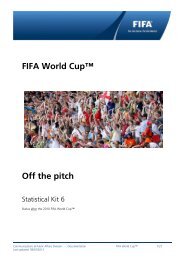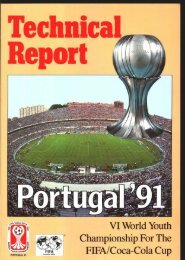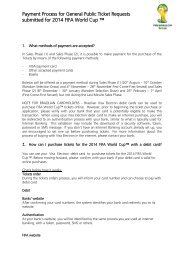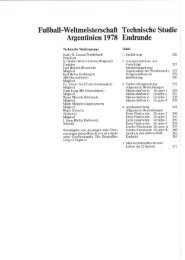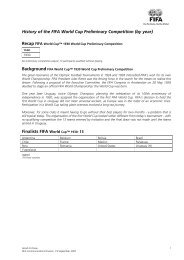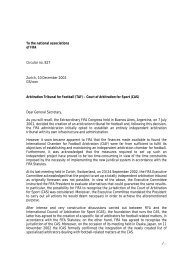World Championship --Jules Rimet Cup 1966 Final ... - FIFA.com
World Championship --Jules Rimet Cup 1966 Final ... - FIFA.com
World Championship --Jules Rimet Cup 1966 Final ... - FIFA.com
You also want an ePaper? Increase the reach of your titles
YUMPU automatically turns print PDFs into web optimized ePapers that Google loves.
MEXICO<br />
The Mexican team played to a 1-4-4-2 system in the first match against<br />
France, i . e . with only two players in the forward attacking positions.<br />
In attacking, therefore, there was a good deal of slow interpassing in<br />
mid-field, whilst other forwards moved up to more advanced positions of<br />
play. Only eleven shots were made, insufficient to justify victory . In<br />
the second match against England, Mexico played <strong>com</strong>pletely on defence,<br />
using at times a 1-9-1 formation . Though England attacked throughout<br />
the game, the defensive barrier held the scoring to two goals . The last<br />
match against Uruguay showed a new Mexico playing 1-4-2-4, building<br />
up good attacks and making many chances to score . With four forwards<br />
in attack, players interchanged positions intelligently and with effect .<br />
The defenders in this game were quick to intercept and to start up counter<br />
attacks . All three matches were vitally different from a tactical point of<br />
view.<br />
SWITZERLAND<br />
Playing 1-4-2-4, the Swiss team looked technically as good as the West<br />
German side in their first match, but they lacked the strength and speed<br />
and gradually began to look slow in <strong>com</strong>parison, both in running to<br />
cover in defence and in interpassing exchanges . In the second game<br />
against Spain, Switzerland tried hard, but this was a negative game with<br />
defences on top and though Switzerland were better at push and run<br />
play, they could not withstand the pressure when winning 1-0 . Argentina,<br />
in the last match, seemed to be content in holding Switzerland to a draw,<br />
but after scoring they could rely on a six to eight man defensive barrier<br />
to hold the Swiss team, now desperate to achieve some success . The<br />
crowd in this match gave its encouragement to Switzerland . Decisions on<br />
balance went against Argentina but they took this well. To their credit,<br />
Switzerland in all their matches never stopped trying, but it was apparent<br />
that the teams fielded had not sufficient skill or driving power to over<strong>com</strong>e<br />
any of the strong opponents .<br />
SPAIN<br />
Looking back, the first match against Argentina was undoubtedly vital<br />
for Spain . Playing 1-4-2-4, they were as cautious as Argentina in the<br />
opening stages, but as soon as Argentina scored, Spain attacked with six<br />
to seven men to equalise . The game was then well balanced until Argentina<br />
scored a second goal . The individual play of some Spanish players<br />
32






